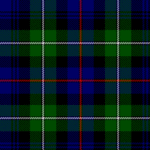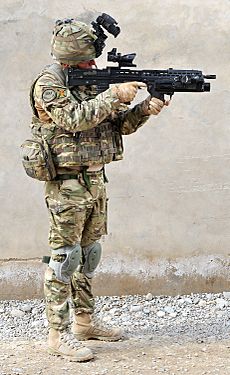Royal Highland Fusiliers facts for kids
Quick facts for kids Royal Highland Fusiliers, 2nd Battalion, The Royal Regiment of Scotland (2 SCOTS) |
|
|---|---|

Cap badge
|
|
| Active | 20 January 1959–present |
| Country | |
| Branch | |
| Type | Infantry |
| Size | Battalion 628 personnel |
| Part of | 4th Infantry Brigade and Headquarters North East |
| Garrison/HQ | Glencorse Barracks, Penicuik |
| Motto(s) | Nemo Me Impune Lacessit (No One Assails Me With Impunity) |
| March | Whistle o'er the Lave o't/The British Grenadiers |
| Anniversaries | Assaye (23 September) |
| Insignia | |
| Tactical recognition flash |  |
| Tartan | HLI Mackenzie |
| Hackle | White From Royal Scots Fusiliers |
The Royal Highland Fusiliers, 2nd Battalion, The Royal Regiment of Scotland (2 SCOTS) is a special group of soldiers. They are an infantry battalion, which means they are trained to fight on foot. They are part of the larger Royal Regiment of Scotland.
Before 2006, the Royal Highland Fusiliers was a separate army group. It was formed in 1959. This happened when two older regiments, the Royal Scots Fusiliers and the Highland Light Infantry, joined together.
Contents
History of the Royal Highland Fusiliers
The Royal Highland Fusiliers (Princess Margaret's Own Glasgow and Ayrshire Regiment) started on January 20, 1959. This was when the Royal Scots Fusiliers and the Highland Light Infantry combined. People often called them 'The RHF'. They were part of the Scottish Division of the army.
Early Deployments and Moves
The regiment first stayed at Redford Barracks in Edinburgh. In 1960, they moved to Singapore Lines in Aden. Their band even played music at independence events in Hargeisa that year.
They then moved to Malta in 1961 and Germany in 1963. In 1965, they spent six months in Cyprus. They were part of the United Nations Peacekeeping Force in Cyprus, helping to keep peace. In 1967, they moved to Fort George, Scotland.
Service in Gibraltar and Northern Ireland
In 1968, the regiment went to Gibraltar for six months. They helped with border duties there. After this, they served five times in Northern Ireland during the 1970s. This was a period of conflict known as the Troubles.
They moved to Bulford Camp in 1970. After two years in Malaysia, they returned to Edinburgh in 1973. Then, they moved to Germany in 1979.
Later Deployments and Amalgamation
The regiment was in Holywood in 1983 and Berlin in 1985. They briefly returned to Edinburgh before moving to Cambridge in 1989.
In 1991, they took part in the Gulf War. After that, they moved to Germany in 1993. From there, they sent soldiers to Bosnia in 1994. They also went to Macedonia and Kosovo in 1999.
The regiment moved back to Fort George in 2000. In 2003, they went to Cyprus. The battalion was involved in Operation Telic in Iraq in 2004 and again in 2006.
In 2006, the Royal Highland Fusiliers joined with other Scottish regiments. They became the 2nd Battalion of the Royal Regiment of Scotland. This change happened on March 28, 2006. The battalion also moved to Glencorse Barracks in Penicuik.
Recent Activities
In 2015, parts of the battalion went to Afghanistan. Their job was to help train the Afghan National Army.
More recently, the battalion joined the 4th Infantry Brigade and Headquarters North East. They work as a light infantry battalion. This means they are trained to move quickly.
Regimental Traditions and Uniforms

This regiment has some special traditions. They are one of the few British infantry regiments to carry three special flags, called Colours, during parades. These include the Queen's Colour, the Regimental Colour, and the Assaye Colour.
The Assaye Colour was given to an earlier regiment in 1803. It was for their brave service at the Battle of Assaye in India. This battle was led by Sir Arthur Wellesley, who later became the Duke of Wellington.
Unique Customs and Dress
The regiment has a unique way of giving the "Attention" command. They say the full, long command, unlike other army groups. They also call the Commanding Officer's disciplinary meetings "haul up." This comes from old times when they guarded prisoners.
Their uniform includes a blue Glengarry cap. This cap has a red bobble on top and a special pattern. They also wear tartan trousers called trews in the Mackenzie pattern. Their shoes are black highland brogues with white spats.
When in combat, they might wear a khaki 'tam o'shanter' bonnet. This bonnet has a Mackenzie tartan patch. They also wear a white hackle (a feather plume) from the Royal Scots Fusiliers. Their cap badge shows a "flaming grenade" with the Highland Light Infantry's symbol.
Battle Honours: Awards for Bravery
The regiment has received over 200 battle honours. These are special awards for their bravery and service in battles. They have earned these honours in many conflicts since 1689. This number is more than any other unit in the British Army.
Some of their battle honours include:
- Blenheim (1704)
- Assaye (1803)
- The Storming of Badajos (1812)
- Vitoria (1813)
- Waterloo (1815)
- Inkerman (1854)
- Gheluvelt (1914)
Forty-four battle honours are shown on the Regimental Colour. Twenty-nine are on the Queen's Colour. Two, Seringapatam and Assaye, are on the Assaye Colour.
Royal Family Connections
The regiment has had special connections with the Royal Family.
- From 1959 to 2002, Princess Margaret, Countess of Snowdon was their Colonel-in-Chief.
- From 2003 to 2022, Prince Andrew, Duke of York held this role.
The Regimental Pipe Band
The Royal Highland Fusiliers have a Pipes and Drums band. The pipers wear a blue Glengarry cap and a Dress Erskine tartan kilt. Drummers also wear the kilt but have a different Glengarry. Buglers wear Mackenzie tartan trews.
The band members have a special cap badge. It combines the regiment's "flaming grenade" with the cross of St Andrew and the star of the Order of the Thistle. The Drum major wears Mackenzie tartan trews and a scarlet jacket.
These band members are regular soldiers first. They are also trained as assault pioneers. This means they are skilled in using explosives and making entrances.
Regimental Headquarters and Museum
The regiment's main office and museum are in Glasgow. The building was designed by Charles Rennie Mackintosh. It is located near Charing Cross on Sauchiehall Street.
The battalion also has a recruitment team in the Maryhill area of Glasgow. A magazine called The Journal of the Royal Highland Fusiliers is published for the regiment. There are also groups for former soldiers connected to the regiment.
Alliances with Other Military Units
The Royal Highland Fusiliers have alliances with other military units around the world:
 Canada – The Royal Highland Fusiliers of Canada
Canada – The Royal Highland Fusiliers of Canada New Zealand – The Royal New Zealand Infantry Regiment
New Zealand – The Royal New Zealand Infantry Regiment Pakistan – 11th Battalion, The Baloch Regiment
Pakistan – 11th Battalion, The Baloch Regiment South Africa – Chief Maqoma Regiment
South Africa – Chief Maqoma Regiment United Kingdom – Inkerman Company, West Lowland Battalion ACF
United Kingdom – Inkerman Company, West Lowland Battalion ACF
See also
- The Canadian Crown and the Canadian Armed Forces


